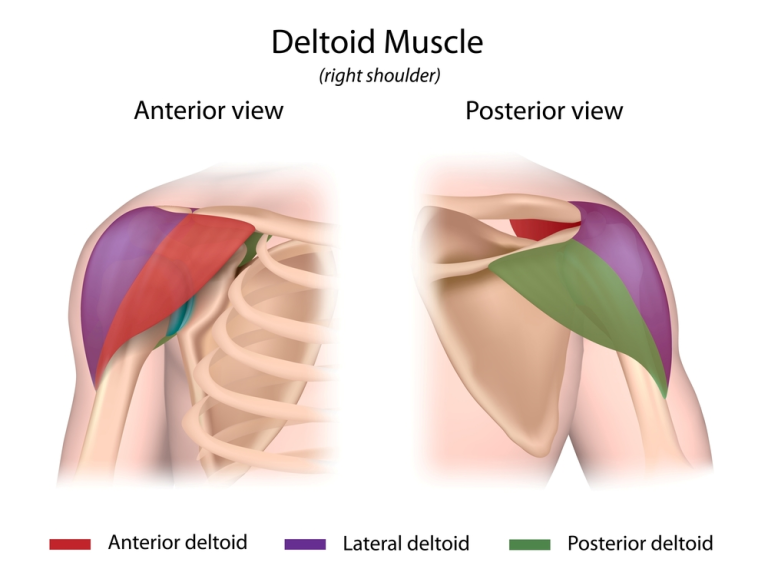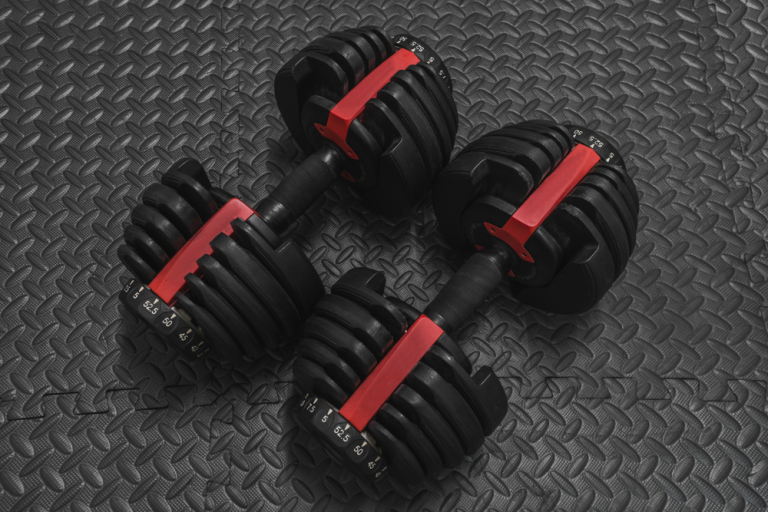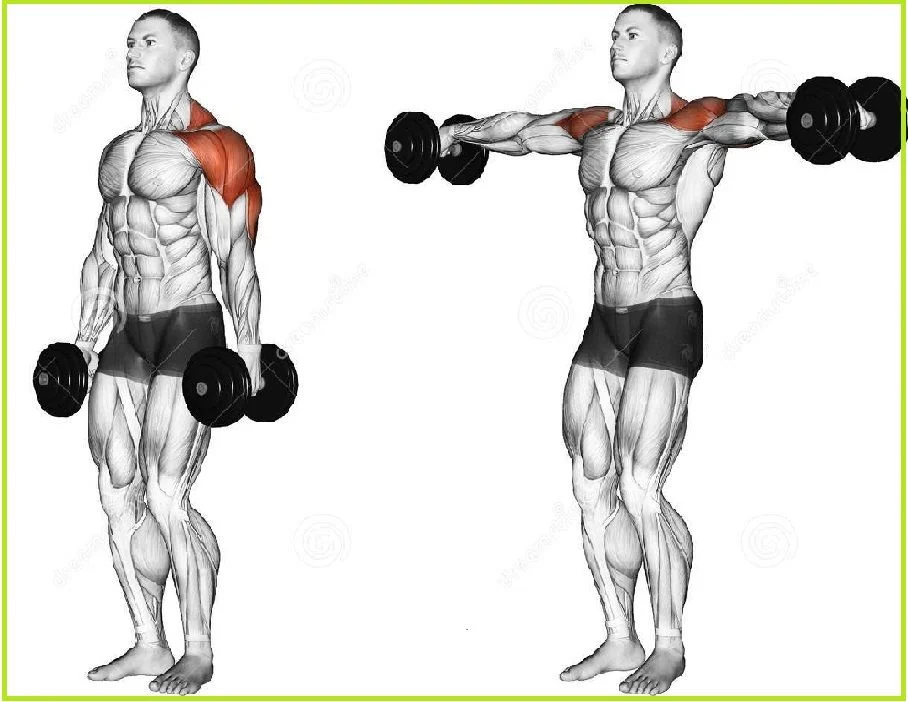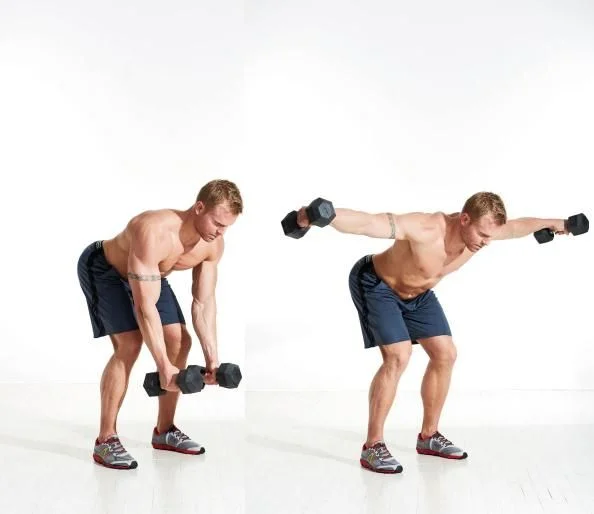Your shoulder Exercises with Dumbbells and Bench are one of the most important joints in your body. They allow you to perform a wide range of movements, from reaching overhead to pushing and pulling objects. If you want to have strong and healthy shoulders, you need to include regular shoulder exercises in your workout routine.
Dumbbells are a great way to train your shoulders. They allow you to isolate each muscle group and target them specifically. In addition, dumbbells can help you improve your balance and coordination.
In this article, we will discuss the best shoulder exercises that you can do with dumbbells and a bench. We will also provide instructions on how to perform each exercise correctly.
- Benefits of Shoulder Exercises with Dumbbells and Bench
- Shoulder Anatomy
- Equipment Needed For StrengthLog’s Shoulder Workout With Dumbbells at Home
- Warming Up
- Best Shoulder Exercises with Dumbbells and Bench: Work Ways
- How Many Times Per Week Should You Do StrengthLog’s Shoulder Exercises with Dumbbells and a Bench?
- Frequently asked questions
Benefits of Shoulder Exercises with Dumbbells and Bench
Your shoulder muscles are important for both appearance and function.
Few things create the image of an athletic body more successfully than broad shoulders. Bodybuilders prize enormous shoulders with a 3D appearance for a competitive advantage, but few would deny that wide, muscular shoulders enhance the appearance of any physique.
Shoulder strength is vital for practically any work in terms of performance and athletics. Having strong shoulders means improved performance whether you’re throwing, pulling, or pushing.
Even if you don’t care about bulking up your shoulders or improving your athletic ability, having above-average shoulder strength makes most tasks in life easier and helps prevent shoulder soreness.
Stronger shoulders assist people of all fitness levels. Fortunately, the finest shoulder exercises can be done at home and don’t require a lot of pricey gym equipment.
With only a pair of dumbbells and StrengthLog’s Shoulder Workout With Dumbbells, you may execute all of the greatest shoulder exercises to achieve your fitness goals, whether they be muscle growth, muscle function, or muscle strength.
Here are some of the benefits of shoulder exercises with dumbbells and a bench:
Improved strength and stability: Shoulder exercises can help to strengthen the muscles in your shoulders, which can improve your overall strength and stability. This can be helpful for activities such as lifting weights, carrying groceries, and even just carrying your backpack.
Increased range of motion: Shoulder exercises can help to increase the range of motion in your shoulders. This can help to prevent injuries and make everyday activities easier.
Reduced risk of injury: Strong and stable shoulders can help to reduce your risk of injuries such as rotator cuff tears and shoulder impingement.
Enhanced posture: Strong shoulders can help to improve your posture. This can make you look and feel better, and it can also help to reduce back pain.
Improved athletic performance: Shoulder exercises can help to improve your athletic performance. This is especially true for athletes who participate in overhead sports such as volleyball, basketball, and tennis.
If you are looking for a way to improve your strength, stability, range of motion, and overall health, then shoulder exercises with dumbbells and a bench are a great option.
Shoulder Anatomy
Before we get started, let’s take a look at how your deltoid muscles work. Don’t worry: we’ll keep it brief and straightforward.
Many people believe that the deltoid is a little muscle, yet it is one of the largest in the upper body. The volume of the deltoid is much bigger than that of the latissimus dorsi and pectoralis major, two muscles that most people think of as huge.
Here are the main movements for the deltoid with the muscles involved:
| Shoulder Movement | Deltoid Muscle | Exercise Example |
|---|---|---|
| Shoulder Extension | Posterior | Dumbbell Pullover |
| Shoulder Flexion | Anterior | Front Raise |
| Shoulder Abduction | Middle | Lateral Raise |
| Shoulder Adduction | Posterior | Chin Up |
| Shoulder Horizontal Abduction | Middle & Posterior | Bent-Over Reverse Fly |
| Circumduction | All Three | CARS (Controlled Articular Rotations) |

- The anterior deltoid, lateral deltoid, and posterior deltoid are the three heads of the shoulder muscles. Or, to make it easier to remember, your front delts, side delts, and back delts. Each can be isolated more or less by employing distinct exercises that target a specific head.
- Your front delts’ principal role is to propel your arms forward. The bench press, for example, and all types of shoulder presses efficiently work the front heads of the deltoids.
- When you perform workouts like the bench press or the overhead press, your side delts help stabilize your shoulder joint by lifting your arms to your sides. To isolate your side delts, include a side rise in your shoulder program, such as the dumbbell lateral raise. The lateral deltoid is also referred to as the medial deltoid, which is incorrect because “medial” refers to something adjacent to your midline, not “middle.”
- Your rear deltoids, an often-overlooked or underutilized muscle, aid in the external rotation of your shoulders and in pulling your arms back when performing exercises like the face pull or rows for your upper back. In all shoulder extension motions, your back delts collaborate with your lats.
- While not a deltoid muscle, the rotator cuff is made up of four tiny muscles and tendons that surround your shoulder joint. The rotator cuff muscles hold your upper arm in position in the shoulder socket.
You must train all three heads of the deltoids for total delt development. This routine is one of the best shoulder workouts for your delts since it uses dumbbell exercises in all planes of motion while leaving no area of the shoulder out.
Equipment Needed For StrengthLog’s Shoulder Workout With Dumbbells at Home
Many people believe that in order to adequately train your shoulders, you must have a fully equipped gym. The good news is that you don’t! Your home gym doesn’t even need to have more than a couple of dumbbells.
Dumbbells can be used for all of the greatest workouts for increasing shoulder width and strength. However, you will need at least one pair of dumbbells, ideally two, unless you obtain adjustable ones. There will be more on those later.
Because compound motions such as presses can take larger loads than isolation exercises such as side raises, you must have access to both bigger and lighter weights.
Ideally, you have one pair of light dumbbells and one pair of heavy dumbbells at hand.
- Recommended intermediate dumbbells for women: a pair of 10 and 15-pound dumbbells.
- Recommended intermediate dumbbells for men: a pair of 15 and 25-pound dumbbells.
Note that these are just recommendations for the average man and woman. A pair of dumbbells that feels light for you might be heavy for someone else, and vice versa. We all have different strength levels, but the above suggestions suit most people.
If you’re an advanced lifter, you likely already know what dumbbells you need to get a good shoulder workout.
A pair of adjustable dumbbells is another option. You may change the weight of an adjustable dumbbell by just flipping a switch, making it simple to transition from a lighter burden to a higher load without having many sets of dumbbells laying around.
Adjustable dumbbells are an excellent way to raise your training load as you gain strength without purchasing new, heavier weights.

In addition to the dumbbells, you should consider purchasing a resistance band for times when you are not at home but still want to exercise. If you’re traveling, for example, you probably don’t want to bring numerous dumbbells, but a resistance band takes up nearly little room and weighs almost nothing. Resistance bands can be used for all of the exercises in this dumbbell shoulder workout.
Warming Up
Because the shoulder joint is complex and has a unique range of motion, you might want to do shoulder-specific dynamic warm-up movements before picking up your dumbbells for the first set.
- Arm circles, going from small circles to a full range of motion, for both your left and right arm.
- Pendulum circles for the rotator cuff muscles.
- Shoulder rolls, both forward and backward.
- Overhead pressing movements without any external load.
StrengthLog’s Shoulder Workout With Dumbbells at Home: The Exercises
Best Shoulder Exercises with Dumbbells and Bench: Work Ways
It’s time to start lifting weights! The workout comprises of five different movements that target all three heads of the deltoid and provide an excellent workout for shoulder size and strength.
Dumbbell Shoulder Press

The dumbbell shoulder press works your front and side deltoids. It’s a compound exercise that allows you to use heavy weights to build size and strength.
According to research, performing dumbbell shoulder presses in the standing position means the highest neuromuscular activity of the deltoid muscles, more significant than when using a barbell and when compared to the seated version of the exercise. Standing up also involves your core muscles more effectively.
If you prefer to do the dumbbell press while seated and have access to a training bench, the seated dumbbell shoulder press is a great alternative exercise. Raise the backrest of an incline bench until it is nearly vertical, and you are ready to go.
Use a full range of motion and straighten your arms upward without utilizing momentum. You want your deltoids to do as much work as possible, avoiding turning the exercise into a dumbbell push press by leveraging your leg drive
Heavyweight = good. Being too heavyweight = means you cheat yourself out of the best results.
How to Dumbbell Shoulder Press
- Stand upright with your feet shoulder-width.
- Grab a pair of dumbbells, and lift them up to the starting position at your shoulders.
- Inhale and lightly brace your core.
- Press the dumbbells up to straight arms, while exhaling.
- Inhale at the top, or while lowering the dumbbells with control back to your shoulders.
- Repeat for reps.
The Arnold press is an alternative way to perform the standard dumbbell press. One small study actually found it to be even more effective for involving the front and side delts
It’s fairly similar, but you start with a pair of dumbbells at shoulder height, palms facing your body. While pressing the dumbbells overhead, swivel your palms to face forward. Return the dumbbells to the starting position while turning your hands to face your body.
Monkey Row

The monkey rows are a terrific but often overlooked exercise that should be included in your shoulder workout.
Monkey rows are a variation of the dumbbell upright row but without the possibility of shoulder joint stress. It primarily targets your side deltoids, but also your upper traps and back deltoids, and it allows folks who are unable to perform traditional upright rows to receive the advantages without the hazards.
Use a weight that permits you to draw the weight as high as you can comfortably, and avoid turning the monkey row into a shoulder shrug. Some shrugging motion is acceptable, but you should feel it mostly in your side delts rather than your traps.
At the top of the action, contract your delts and concentrate on your side deltoids before lowering the weights with proper form and total control.
Instructions
- With your arms by your sides, hold a dumbbell in each hand.
- From the start position, pull the dumbbells straight up as far as you can.
- With control, lower the dumbbells back to the starting position.
Dumbbell Lateral Raise

While presses are your primary source of shoulder mass, lateral raises isolate your side delts and are one of your best chances for increasing shoulder width.
Allow your ego to choose the weights for the optimum results. Instead, utilize low weights to isolate your side delts and prevent overloading your front deltoids and traps.
How to Do Dumbbell Lateral Raises
- Hold a pair of dumbbells, in almost straight arms hanging by your sides.
- With control, lift the dumbbells outwards to your sides, until your upper arms are horizontal and your hands are at or slightly above shoulder level.
- Lower the dumbbells with control.
- Repeat for reps.
Dumbbell Front Raise

All types of exercises for both your chest and shoulders work your front delts, but the best exercise in your repertoire for isolating them is the front raise.
Because your anterior delts are highly involved in many other actions, you’ll complete the fewest number of sets of front raises of any exercise in this shoulder workout.
Another exercise where you don’t want to go too heavy is the front rise. It’s all too easy to start swinging and employing more weight than you’re capable of. However, you don’t want to turn this solitary exercise into a kettlebell swing hybrid. Instead, use a lesser weight and concentrate on lifting the dumbbell with simply your front delts.
How to Do Dumbbell Front Raises
- Hold a pair of dumbbells in straight arms, in front of your thighs or hip.
- With control, lift the dumbbells forward with straight arms, until the dumbbells are at shoulder height.
- Reverse the movement and lower the dumbbells with control.
Front raises can also be performed by lifting one arm at a time. When you lower your right hand, meet it halfway with your left hand, and so on.
Reverse Dumbbell Fly


Your back delts may be difficult to see in the mirror, but they are vital for total shoulder development and performance.
Most people get some posterior delt training via back exercises like rows, but if you never specifically target them, they may become underdeveloped. Now comes the dumbbell reverse fly.
Reverse flies do not completely isolate the back deltoid because your upper traps are also engaged, but it is an excellent exercise for balancing the front and back delts.
Choose a pair of dumbbells that you can lift without using your upper body or hips. Lifting overly large weights, as with other dumbbell raise variations, removes tension from the muscle you’re attempting to strengthen.
How to Do Reverse Dumbbell Flyes
- Hold a pair of dumbbells, lean forward, and let your arms hang towards the floor.
- With almost straight arms (just a slight bend at the elbow), slowly lift the dumbbells by raising your arms out to the sides in a wide arc.
- Reverse the movement and lower the dumbbells back to the starting position.
Whew! You’ve completed your shoulder workout! You should be feeling a great pump now that you’ve worked all three heads of your delts thoroughly. Maintain this program on a regular basis, and your shoulders will become stronger and more muscular
How Many Times Per Week Should You Do StrengthLog’s Shoulder Exercises with Dumbbells and a Bench?
Depending on your fitness level, goals, and training experience, this at-home dumbbell shoulder workout should be done once or twice a week.
- One weekly shoulder workout is enough for optimal strength and muscle development for intermediates.
- Advanced lifters and bodybuilders can benefit from doing it twice per week for a greater training volume to boost muscle growth.
Current research suggests you need at least ten weekly sets per muscle group for the best possible results. If you have extensive training experience, you might benefit from up to 20 sets per muscle group per week.

Keep in mind that your shoulders are distinctive in terms of sets per muscle group. You can isolate distinct deltoid heads, which means you don’t work your front delts while you do movements for your back delts, and so on. Furthermore, when you train your chest and back, your delts are strongly involved.
Regardless of your training experience or how you work the rest of your body, StrengthLog’s Shoulder Workout With Dumbbells has you covered. You always get at least as many sets as you need to maximize your growth without overworking any muscle group.
Frequently asked questions
how do you get big shoulders with dumbbells?
Dumbbell front raise.
Dumbbell side lateral raise.
Dumbbell bent-over raise.
Dumbbell upright row.
Dumbbell shoulder shrugs.
One arm dumbbell swing.
Spellcaster.





